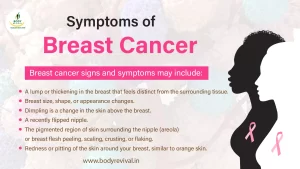Breast cancer is the second most common cancer diagnosed in women. Breast cancer can affect both men and women, but women are far more likely to be affected.
Breast cancer is a type of cancer that develops in the cells of the breasts.
Significant support for breast cancer awareness and research funding has aided in advancing breast cancer diagnosis and therapy. The number of deaths related to the disease has decreased due to earlier detection, customised therapy, and improved understanding of the illness, resulting in higher survival rates.
Symptoms of Breast Cancer
Breast cancer signs and symptoms may include:
- A lump or thickening in the breast that feels distinct from the surrounding tissue.
- Breast size, shape, or appearance changes.
- A recently flipped nipple.
- The pigmented region of skin surrounding the nipple (areola) or breast flesh peeling, scaling, crusting, or flaking.
- Redness or pitting of the skin around your breast, similar to orange skin.

Types of Breast Cancer
The most prevalent types of breast cancer are as follows:
- Ductal invasive carcinoma: The cancer cells start in the ducts and spread to other breast tissue regions. Invasive cancer cells can also spread to other body parts, known as metastasis.
- Lobular cancer with invasion: Cancer cells develop in the lobules and subsequently move to nearby breast tissues. These invasive cancer cells have the potential to spread to other places of the body as well.
Other types of breast cancer are less frequent, such as Paget’s disease.
Mammogram – When and how to go for it?
Mammogram is a screening procedure for breast cancer. Mammograms are X-ray images of the breast. Doctors use mammography to detect early signs of breast cancer. Regular mammograms are the finest testing available to doctors for detecting breast cancer early, often up to three years before symptoms appear.
Preparing for Mammogram Procedure
You may continue to eat, drink, and take prescriptions as usual.
Inform your doctor or technician if you are pregnant or suspect you are pregnant.
Do not apply body powder, cream, deodorant, or lotion on your chest on the test day. They may cause interference with the X-rays. You will be asked to remove all jewellery and clothing above the waist and change into a hospital gown. Consider wearing a two-piece outfit on the test day.
How Well Do Mammograms Work?
Mammogram for breast cancer aid in diagnosing 75% to 85% of breast malignancies. Because breasts become less thick as a woman ages, detection rates improve. This improves the visibility of tissue on mammograms.
Technology advancement increases detection rates. According to one study, employing 3D mammography in conjunction with digital mammography enhanced detection rates and reduced the proportion of women who had to return for additional examinations due to a worrisome discovery.
New research constantly adds to the controversy about mammography and breast cancer screening. Respected national groups have different recommendations for when to start mammograms and how frequently they should be repeated. The pandemic has undoubtedly added to the uncertainty. Understandably, folks have concerns about this critical healthcare decision.
When Should I Get a Mammogram?
Breast cancer risk increases with age. However, doctors disagree on the best time to get your first mammogram.
It is recommended that women aged 40 to 44 have the option of beginning yearly screening mammograms. Women aged 45 to 54 should get a mammogram yearly, while those aged 55 and up should have one every 1 to 2 years. However, it is also said to have screening every two years between the ages of 50 and 74. It says the decision to begin yearly screening mammograms before age 50 should be made individually.
Suppose your doctor advises you that you are at high risk for breast cancer or have close family members diagnosed at a young age. In that case, you should consider getting examined sooner.
Most specialists advise continuing to receive these screenings as long as you are in excellent health and anticipate to live for at least another ten years. Mammograms are an important part of your health history. If you change doctors or relocate, take the film (Mammogram) with you.
Conclusion
It’s not always possible to detect cancer through Mammogram, especially in younger women with denser breast tissue. Breast exams may also be performed by your health care provider (physician or nurse) every three years, beginning at the age of 20 and every year beginning at the age of 40.
Although mammography is the most effective breast cancer screening method for most women today, it has flaws. Mammography misses approximately 13% of breast cancers. Mammography may miss more breast tumours depending on various conditions (such as increased breast density).
Some breast cancers are more difficult to detect with mammography than others.
Mammography, for example, detects invasive ductal carcinomas more well than invasive lobular carcinomas. Because invasive lobular carcinomas may not usually appear as a distinct mass on a mammogram, they are more difficult to detect. Other imaging methods, besides mammography, are being researched for routine breast cancer screening.